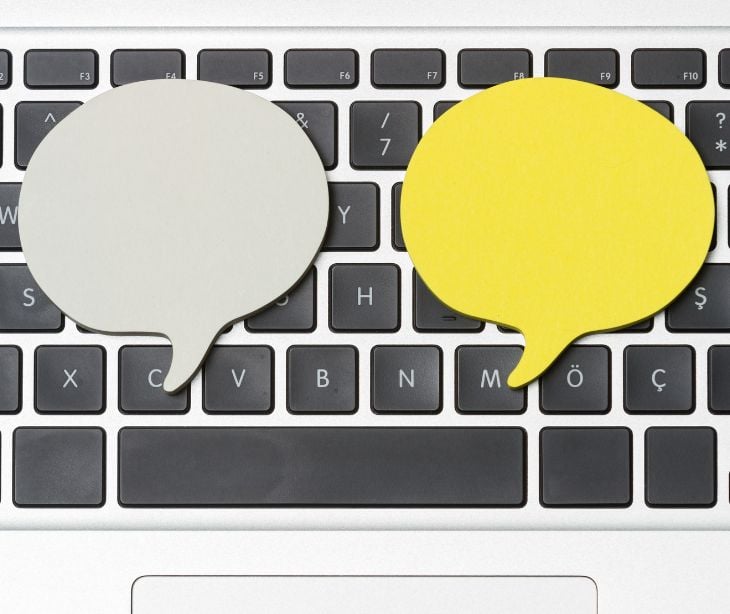
Instant messaging provides a flexible and effective way for healthcare professionals and patients to exchange information. With instant messaging platforms, healthcare organizations can improve care coordination, boost patient engagement, and simplify administrative tasks, resulting in enhanced outcomes and experiences for everyone involved. As technology advances, instant messaging's role in healthcare is set to grow, significantly shaping medical communication's future.
What is instant messaging?
Instant messaging is a form of real-time communication between two or more people. It allows users to exchange text messages, images, videos, and other types of files instantly through an app or platform.
Unlike traditional email communication, instant messaging provides immediate feedback from the recipient and offers a sense of urgency. This makes it an efficient way for healthcare professionals to communicate with their patients.
Healthcare providers can use instant messaging to promptly respond to patient inquiries or provide status updates on test outcomes. Patients can also use these platforms to schedule appointments and offer feedback regarding their treatment plans.
Although some contend that instant messaging in healthcare carries risks such as confidentiality and miscommunication problems, leveraging this tool effectively with appropriate data protection measures can significantly advance doctor-patient communication.
How can instant messaging be used in healthcare?
Instant messaging has countless applications in the healthcare industry, making communication between patients and doctors more accessible and efficient.
Patients can utilize instant messaging to inquire about urgent matters or share health updates with their doctor. Secondly, it facilitates virtual consultations, enabling doctors to provide medical advice remotely via secure chat platforms, eliminating the need for physical visits.
Furthermore, instant messaging streamlines internal communications within hospitals or clinics, enhancing collaboration among nurses, doctors, and other staff members.
Instant messaging also benefits patient engagement by sending medication schedules or appointment reminders through automated chatbot systems.
Instant messaging apps
HIPAA compliant instant messaging services are similar to popular consumer apps such as Skype, WhatsApp, Viber, WeChat, and Telegram. They facilitate instant communication through messages and the sharing of files while enabling voice and video calls to be made.
A study titled Security and other ethical concerns of instant messaging in healthcare, has estimated that WhatsApp has about 12 billion users. This demonstrates the widespread use of instant messaging apps.
It is important to note that consumer instant messaging apps cannot be used in connection with electronic protected health information and should not even be used for voice or video calls in which patient information is discussed. These apps often lack the security features and regulatory compliance measures required to protect sensitive patient information under HIPAA.
See also:
Advantages of instant messaging in healthcare
- Real-time communication: Instant messaging enables instantaneous communication, allowing individuals to exchange messages instantly regardless of their location. This immediacy is invaluable in situations requiring quick responses or urgent information sharing.
- Convenience and accessibility: Instant messaging platforms are easily accessible via smartphones, tablets, or computers, making it convenient for users to stay connected wherever they are. This accessibility promotes seamless communication without the constraints of time or location.
- Cost-effective: Many instant messaging apps are free to use, requiring only an internet connection. This makes them a cost-effective alternative to traditional forms of communication, such as phone calls or postal mail, especially for international or long-distance communication.
- Privacy and security: Many instant messaging platforms prioritize user privacy and security, offering end-to-end encryption and other security features to protect sensitive information from unauthorized access or interception.
- Efficient communication among healthcare professionals: Instant messaging facilitates quick and easy communication between doctors and medical staff regarding patient care, leading to improved efficiency, reduced errors, and better patient outcomes.
- Enhanced patient-doctor communication: Instant messaging allows patients to address questions or concerns outside of scheduled appointments, fostering direct communication with their doctors.
- Remote collaboration on complex cases: Medical staff can collaborate remotely through instant messaging, particularly beneficial for complex cases requiring coordination among multiple specialists across different locations.
Related: How text messaging can help promote accessibility
Ensuring HIPAA compliance with instant messaging
Ensuring HIPAA compliance with instant messaging in healthcare is essential for protecting patient privacy and meeting regulatory requirements. Here are key practices:
- Choose HIPAA compliant platforms: Use instant messaging platforms specifically designed for healthcare use that adhere to HIPAA regulations.
- Implement secure authentication: Enforce strong login methods, like unique usernames and passwords.
- Encrypt messages and data: Ensure that all messages and data transmitted through instant messaging are encrypted to prevent unauthorized access or interception.
- Establish access controls: Define access levels and permissions to restrict user access to sensitive patient information based on their role and responsibilities within the healthcare organization.
- Train staff on HIPAA compliance: Provide comprehensive training to healthcare staff on HIPAA regulations, including guidelines for using instant messaging securely and responsibly. Emphasize
- Monitor and audit messaging: Regularly review activity logs to identify security breaches.
- Enable remote wipe and data policies: Enable remote wipe capabilities on devices used for instant messaging to remotely erase data in case of loss or theft. Implement data retention policies to specify how long messages and attachments should be stored before being securely deleted.
- Obtain business associate agreements (BAAs): Ensure that instant messaging platform providers sign business associate agreements (BAAs) acknowledging their responsibility for safeguarding protected health information (PHI) in compliance with HIPAA.
- Update security measures regularly: Stay informed about the latest security threats and updates related to instant messaging technology. Regularly update software, apply security patches, and review security configurations to mitigate potential risks.
- Conduct risk assessments: Conduct regular risk assessments to identify vulnerabilities and potential security risks associated with instant messaging systems.
HIPAA compliant email as an alternative to instant messaging
HIPAA compliant email serves as an alternative communication tool in healthcare settings, providing a secure and regulated means of exchanging sensitive patient information. While instant messaging offers real-time communication benefits, HIPAA compliant email ensures adherence to the strict privacy regulations set forth by HIPAA. This solution allows healthcare professionals to communicate patient data, including diagnoses, treatment plans, and test results, with confidence in its confidentiality and security.
With features such as encryption, access controls, and audit trails, HIPAA compliant email platforms offer the security necessary for safeguarding patient privacy. Despite its asynchronous nature compared to instant messaging, HIPAA compliant email remains a valuable tool for healthcare organizations seeking secure communication channels while maintaining regulatory compliance.
See also: Top 10 HIPAA compliant email services
FAQs
How can healthcare organizations choose the right instant messaging platform?
When selecting an instant messaging platform for healthcare use, organizations should prioritize security, compliance with healthcare regulations, ease of use, interoperability with existing systems, and vendor support. Conducting thorough evaluations and considering user feedback can help make an informed decision.
What measures are in place to ensure patient confidentiality and data security when using instant messaging?
Instant messaging platforms designed for healthcare often implement encryption, access controls, user authentication, and audit trails to safeguard patient information. Additionally, platforms may comply with regulations such as HIPAA to ensure privacy and security standards are met.
Are there limitations to using instant messaging for clinical communication?
While instant messaging offers many benefits, it may not be suitable for discussing urgent or complex medical cases that require immediate attention or detailed documentation. In such cases, direct verbal communication or in-person consultations may be more appropriate.
Subscribe to Paubox Weekly
Every Friday we'll bring you the most important news from Paubox. Our aim is to make you smarter, faster.




